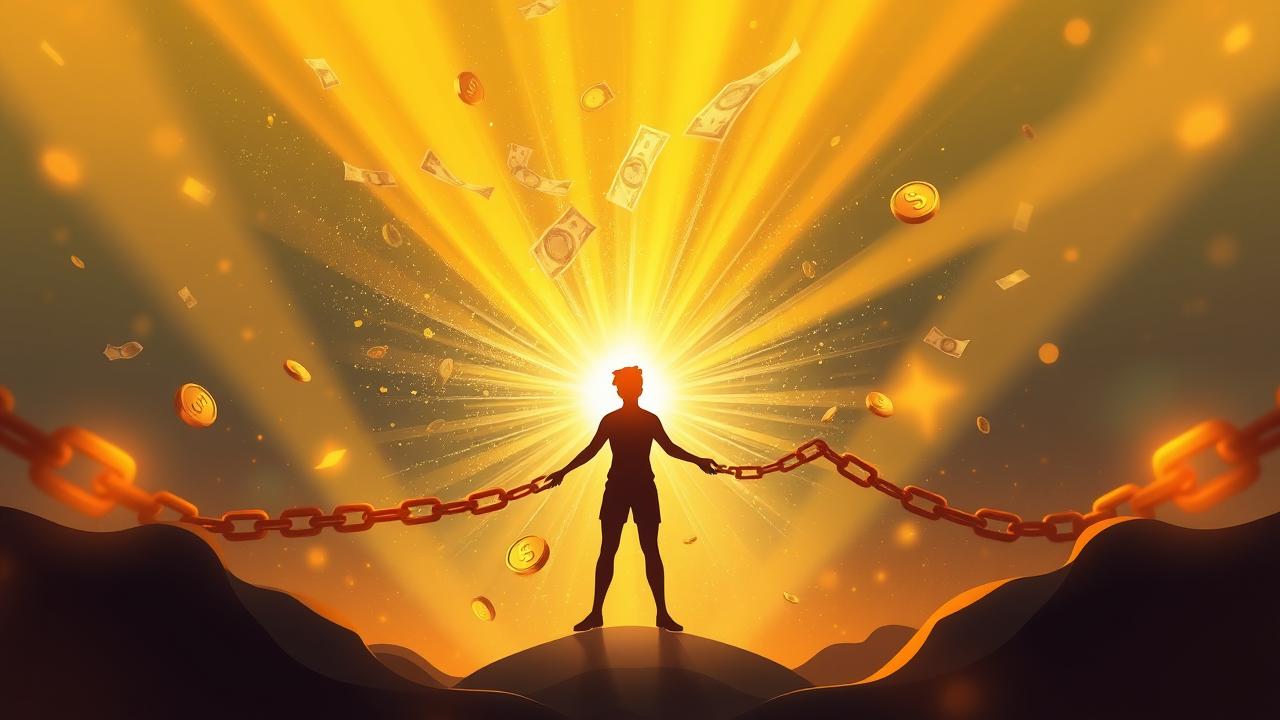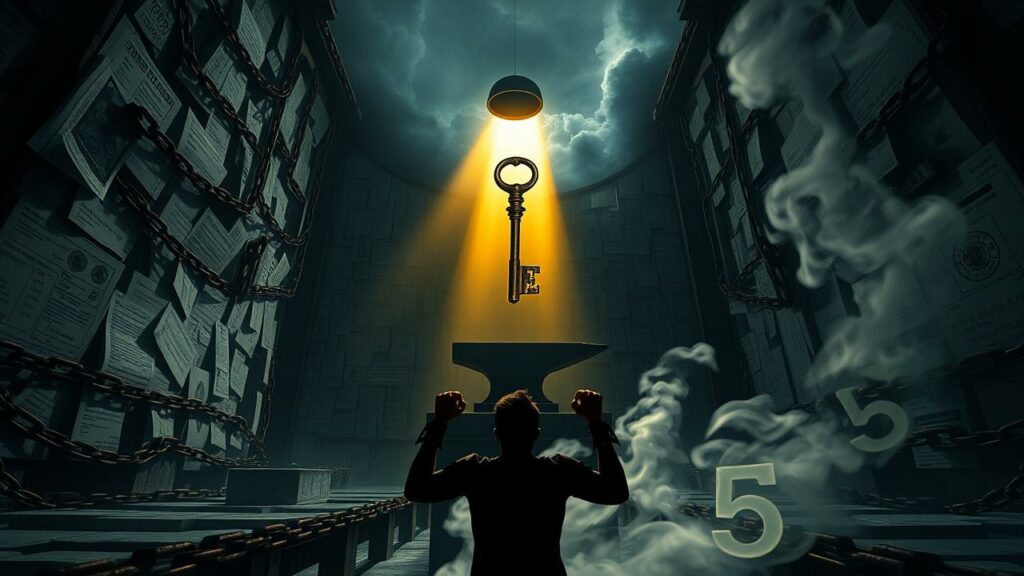When One Payment Is the Only Lifeline You See
The mail doesn’t just arrive. It lands with a soft thud that echoes in the pit of your stomach. You know what’s in there. Not letters from friends, but judgment sealed in crisp, windowed envelopes. Each one is a paper-thin monster, a demand from a different corner of your life, all screaming for the same blood. The air grows thick, heavy with the silent weight of numbers you can no longer outrun. Your breath catches, just for a second. This isn’t living; it’s a slow-motion burial under a mountain of your own making.
But inside that chaos, a single, powerful idea can spark. A thought that feels like the first gasp of air after being held underwater. What if it wasn’t five monsters, or seven, or ten? What if it was just one? The decision to consolidate credit card debt isn’t just a financial transaction. It is an act of defiance. It’s the moment you stop drowning and decide to build a raft, right there in the middle of the flood.
The Escape Plan in Brief
The path out of the suffocating grip of high-interest debt is a war fought on two fronts: the practical and the psychological. First, you face the beast—you inventory every penny you owe, every punishing interest rate. Then, you choose your weapon: a personal loan for a clear-cut battle plan, a 0% balance transfer card for a swift, disciplined assault, or leveraging home equity for the largest campaigns. But this is the crucial part: shuffling debt is meaningless if you don’t change the behaviors that got you here. This is about rewriting your story, not just refinancing the old one.
Step 1: Staring into the Abyss of Your Balance Sheets
The air in Dallas’s small apartment was stale, smelling faintly of old coffee and the rain-soaked jacket he’d slung over a chair. A long-haul trucker, he spent more time with the rumble of a Cummins engine than with human voices. Tonight, silence was the enemy. On his small kitchen table, fanned out under the buzzing fluorescent light like a losing hand of cards, were the bills. Five of them. Each a different shade of urgent.
This is the moment of truth. Before you can even think about which debt consolidation method is your weapon of choice, you must do what Dallas was finally forcing himself to do: look. No more guessing. No more “it’s probably around…”. It requires a cold, unflinching inventory. You need a list—on paper, on a spreadsheet, scratched onto a napkin, it doesn’t matter. What matters is the brutal honesty of the columns: Card Name, Total Balance, APR, Minimum Payment.
That APR column is the real horror show. It’s the measure of how fast you’re bleeding out. Seeing 19%, 24%, even 29% next to a balance that never seems to shrink—that is the very definition of a rigged game. Alongside this, you must check your credit score. This number is your key, or the lock, to the best possible debt elimination strategies, determining whether you qualify for the low-interest escape routes or if you’ll have to fight your way out through the trenches.
The Three Main Arteries of Escape
Once you’ve stared down the numbers, you can choose your path. To consolidate credit card debt is to channel many raging rivers into a single, manageable canal. There are three primary ways to build that canal.
- Personal Loans: This is the most straightforward route. You get a single, fixed-rate loan from a bank, credit union, or online lender to pay off all your credit card balances. What’s left is one predictable monthly payment with a clear end date. It’s a clean break. No more juggling due dates; just one target to hit, month after month.
- Balance Transfer Credit Cards: This is the high-stakes, high-reward option. You move your high-interest balances onto a new card offering a 0% introductory APR for a set period, typically 12 to 21 months. It’s a ceasefire. For that time, every dollar you pay goes to the principal, not to the lender’s bottom line. But it’s a trap for the undisciplined. If that balance isn’t annihilated before the promo period ends, the interest rate can snap back with a vengeance, often higher than what you started with.
- Home Equity (Loans or HELOCs): If you own a home, you can borrow against its value. This often secures the lowest interest rates because your home is the collateral. That last word should send a cold spike of fear right through you, because it should. You’re trading unsecured debt (they can sue you, but can’t take your stuff without a court order) for secured debt. If you falter, you don’t just get angry phone calls—you lose your home. This is a tool for overwhelming debt and must be handled with extreme caution.
Video Callout: The Siren’s Song of Consolidation
Some see debt consolidation as the ultimate trap, a clever shell game that keeps you indebted longer. It’s a cynical take, sure, but one born from watching people get burned. This video dives into that perspective, exploring why it can fail and, more importantly, what actions you must take to ensure it becomes your tool for freedom, not another link in the chain.
The Choice: A Clean Shot or a Race Against the Clock?
In the fluorescent-lit sterility of the dental office where she worked, Viviana was the master of control. Every tool was precisely arranged, every procedure followed a strict, unwavering protocol. Her financial life, however, was a frantic improvisation. Drowning in nearly $18,000 of debt across four credit cards, she seized on a balance transfer offer like a lifeline. 0% APR for 18 months. It sounded like magic.
But the introductory period wasn’t a reprieve; it was a countdown timer bolted to the wall of her mind. Each month, she threw what she could at the balance, but life had other ideas. A transmission repair. A sick cat. The 18 months evaporated. The day the promotional rate expired, the card’s standard APR of 26.99% clamped down on the remaining $7,000 balance. The new interest charges were higher than all her old minimum payments combined. She hadn’t found an escape hatch; she’d found a trap door into a deeper basement.
Viviana’s story is the cautionary tale of balance transfers. They are magnificent tools for those with the discipline and cash flow to pay off credit card debt entirely within the grace period. You must account for the one-time transfer fee (usually 3-5% of the balance), but it’s a small price for a year-and-a-half of zero interest. A personal loan, by contrast, is a march, not a sprint. The interest rate is fixed, the payment is the same every month, and you know the exact date the war will be over. It might not be as cheap if you pay it off fast, but it is predictable. It offers peace of mind, a commodity more valuable than gold when you’re deep in the trenches.
The Hidden Teeth in the Fine Print
It’s easy to be seduced by the headline: “One Low Monthly Payment!” It’s a soothing balm on a very raw nerve. But the devil doesn’t show up in horns and a pitchfork; he shows up in the fee disclosures and amortization schedules. A consolidation loan’s primary purpose is to swap high-interest debt for low-interest debt. That’s how you win. That’s the whole point.
The distinction between bad debt vs good debt here is razor-sharp. Credit card debt, with its compounding interest and soul-crushing rates, is toxic. A structured, lower-rate consolidation loan can be a tool for good. But look closer. Did they tack on an “origination fee” that eats up 5% of your loan before you even get it? Are you stretching a debt you could have paid in three years over a new seven-year term? You might have a lower payment, sure, but you could end up paying thousands more in total interest over the life of the loan. It’s the financial equivalent of slow-boiling a frog. You won’t notice the rising heat until it’s too late.
The Enemy in the Mirror
Consolidating your debt without changing your habits is like getting liposuction and then heading straight to an all-you-can-eat buffet. You’ve treated a symptom, violently and expensively, while completely ignoring the disease. The raw, undeniable truth is this: the debt isn’t the problem. The debt is the result of the problem.
The real work begins now. It is the unglamorous, day-in, day-out grind of building a budget and telling your money where to go, instead of wondering where it went. It’s about identifying the emotional triggers that lead to swiping a card—boredom, stress, a hunger for something you can’t name—and finding healthier ways to cope. These are the real tips to avoid debt in the future.
And for the love of all that is holy, once you pay off those old cards with the consolidation loan, do not—under any circumstances—use them again. Freeing up that credit is a test. The old you sees thousands in available credit. The new you, the person forging a path to freedom, sees a line of landmines you just painstakingly cleared. You don’t walk back into the minefield for a souvenir.
When the Main Gates Are Barred: Guerilla Tactics
Miller had spent forty years in the cab of a tower crane, guiding multi-ton sections of steel into place with millimeter precision. Now retired, the only thing he was trying to move was a mountain of debt, and his most powerful tools were gone. A messy divorce and a few years of leaning too hard on credit had left his score in ruins. No bank would offer him a consolidation loan. The gates were barred. For a moment, a cold, heavy sense of defeat settled over him, the kind that feels permanent.
But you don’t build skylines without learning a thing or two about impossible problems. If he couldn’t get a big loan to wipe everything out at once, he would just have to dismantle the mountain piece by piece. He chose his strategy not with a calculator, but with his gut. He learned about the debt avalanche method, a mathematically perfect attack that targets the highest-interest card first. It made sense. But then he read about the debt snowball method. You pay minimums on everything, but throw every spare cent at the smallest balance, regardless of interest. Once it’s gone, you roll that payment into the next smallest.
It was the snowball that called to him. It wasn’t about math; it was about momentum. Three months later, he paid off a $480 store card. He didn’t just cut the card up. He took it out to the rusty burn barrel in his backyard and set it on fire, watching the plastic curl and blacken into nothing. That small victory, that tangible act of destruction, fueled him. It was proof. He could do this. For those shut out from traditional consolidation, these methods are the answer. They are a testament to the relentless power of focus and will.
If you’re truly overwhelmed and can’t go it alone, professional help exists. Non-profit credit counseling agencies can work with your creditors to create a formal debt management plan (DMP), often with reduced interest rates. It’s more structured than doing it yourself but less destructive than other options. Be wary of for-profit companies promising to negotiate your balances down. This, often called debt settlement, can wreck your credit and leaves you open to lawsuits. It’s a last-ditch, high-risk maneuver in a war where you have far safer options.
Your New Command Center
Winning this fight requires intelligence. You need to see the battlefield clearly. That’s where a good debt payoff calculator becomes your most trusted advisor. It allows you to war-game different scenarios. What happens if you find an extra $100 a month? How much faster will you be free? Seeing the end date pull closer by years, not months, can be the rocket fuel your motivation needs.
Beyond calculators, budgeting apps like YNAB (You Need A Budget) or EveryDollar aren’t just for tracking spending. They are your new financial nervous system. They force you to be intentional, assigning every single dollar a job before the month begins. It transforms your finances from a reactive, chaotic mess into a proactive, strategic operation.
Intel from the Front Lines
Those who have walked this path before have left maps. These books are less about abstract theory and more about practical, psychological armor for the fight ahead.
- Getting Out of Debt For Dummies by Steven Bucci: Don’t let the title fool you; this is a clear, comprehensive, and judgment-free guide to the mechanics of debt elimination. It’s the field manual you need.
- The Complete Debt Relief Manual by John Oswald: This is a deep dive, covering everything from budgeting to negotiating with creditors yourself. It empowers you by showing you the rules of the game the creditors are playing.
- Mastering Your Finances by Adira D. York: A fantastic exploration of the crucial difference between good and bad debt, helping you reframe your entire relationship with borrowing and build a healthier financial future.
Dispatches from the Doubters
Does consolidation hurt your credit?
It’s a dance. Initially, your score might dip slightly when you apply for a new loan or card (a hard inquiry). But the long-term effect is almost always powerfully positive. By paying off multiple credit cards, you lower your credit utilization ratio—a huge factor in your score. You’re also replacing revolving debt with an installment loan, which scoring models tend to view more favorably. A history of consistent, on-time payments on your new consolidation loan will build your score significantly over time.
Is it wise to consolidate credit card debt?
It is wise if, and only if, you do it for the right reason: to get a lower interest rate and simplify your life so you can attack the principal with ferocious intensity. If you see it as a way to lower your payments just so you can free up cash to spend more, it is an act of profound self-sabotage. Consolidation is a tool, not a magic wand. Your wisdom is in how you wield it. For those with a clear plan and the discipline to execute it, it can be the most powerful move you make.
What if I have bad credit and can’t get a loan?
This is where your inner warrior is forged. As Miller’s story shows, the path isn’t blocked; it’s just different. The debt snowball or debt avalanche methods are your weapons now. They require more grit, but the psychological victories are immense. You can also explore options with non-profit debt relief programs through agencies certified by the National Foundation for Credit Counseling (NFCC). They can often negotiate better terms than you could alone, even with damaged credit.
Armory & Allies
You are not alone in this fight. These resources provide unbiased information and a community of fellow fighters.
- Consumer Financial Protection Bureau (CFPB): Your go-to for impartial, government-backed information on debt consolidation.
- Experian: Provides a solid overview of the mechanics and impacts on your credit.
- r/personalfinance: A massive community sharing real-world struggles and successes.
- SoFi: An example of an online lender specializing in consolidation loans.
- Discover Personal Loans: Another major player in the debt consolidation loan space.
Define Today as Day One
The numbers on the page don’t own you. The fear in your chest doesn’t get the final say. The person you were yesterday, who made the choices that led you here, is not the person you have to be tomorrow. The power to change your entire world resides in the very next decision you make. Don’t just read this and feel a fleeting sense of hope. Use it.
Open a calculator. Do the math. See the numbers for yourself. That single action, that one small step into the harsh light of reality, is the start of your own financial independence roadmap. To consolidate credit card debt is a powerful strategy, but the ultimate goal is not just to shuffle payments. The goal is to get out of debt for good. To stand on your own two feet, free from the weight of it all, and finally breathe. Start now.







